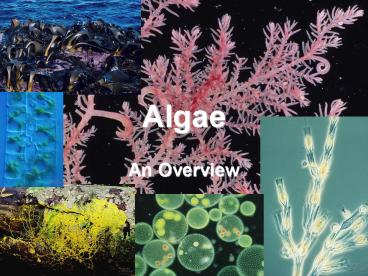Algae - PowerPoint PPT Presentation
1 / 18
Title:
Algae
Description:
Meiosis. Zoospores. Plus and minus gametes. Zygospore. Reproduction in Multicellular Algae ... The spore undergoes meiosis and produces 4 haploid zoospores. ... – PowerPoint PPT presentation
Number of Views:605
Avg rating:3.0/5.0
Title: Algae
1
Algae
- An Overview
2
Characteristics
- Range in size from microscopic to single celled
organisms to large seaweed - Autotrophic
- Form the reproductive structures gametangia or
gamete chambers - Aquatic and have flagella at some point in life
- Often contain pyrenoids, organelles that
synthesis and store starch
3
STRUCTURE
- Thallus (haploid)
- Four types of algae
- Unicellular
- Colonial
- Filamentous
- multicellular
4
IDENTIFY THE TYPE OF ALGAE
5
CLASSIFICATION OF ALGAE
- SEVEN PHYLUM BASED ON
- COLOR
- TYPE OF CHLOROPHYLL
- FOOD-STORAGE SUBSTANCE
- CELL WALL COMPOSITION
6
REPRODUCTION
- MOST REPRODUCE BOTH SEXUALLY AND ASEXUALLY
- Most sexual reproduction is triggered by
environmental stress - Asexual Reproduction
- Mitosis
- Sexual Reproduction
- Meiosis
- Zoospores
- Plus and minus gametes
- Zygospore
7
Reproduction in Multicellular Algae
- Oedogonium reproduction
- Antheridium-release flagellated sperm that swim
to the oogonium - Oogonium-houses the zygote which is a diploid
spore - The spore undergoes meiosis and produces 4
haploid zoospores. One of the four cells becomes
a rootlike holdfast the others divide and become
a new filament.
oogonium
8
holdfast
9
Spirogyra reproduce sexually by conjugation
10
Ulva Reproduces by Alternation of Generations
- Two distinct multicellular phases- one is haploid
and the other is diploid - Gametophyte is haploid
- Sporophyte is diploid
11
Phylum Chlorophyta
- Green algae
- 7000 diverse species
- Biologist reason that green algae give rise to
land plants. - Both green algae and land plants have chlorophyll
a and B as well as carotenoids and store food as
starch - Both have walls made of cellulose
12
Phylum Phaeophyta
- 1500 species of Brown algae
- Mostly marine and include seaweed and kelp
- All are multicellular and large (often reaching
lengths of 147 feet) - Individual alga may grow to a length of 100m with
a holdfast, stipe and blade - Used in cosmetics and most ice creams
13
Phylum Rhodophyta
- 4000 species of RED Algae
- Most are marine
- Smaller than brown algae and are often found at a
depth of 200 meters. - Contain chlorophyll a and C as well as
phycobilins which are important in absorbing
light that can penetrate deep into the water - Have cells coated in carageenan which is used in
cosmetics, gelatin capsules and some cheeses
14
Phylum Euglenophyta
- 1000 species of Euglenoids
- Have both plantlike and animal-like
characteristics - Fresh water
15
Other Phylum Representatives
Diatoms used in detergents, paint removers,
toothpaste
Dinoflagellates red tides
Golden algae
Important in the formation of petroleum products
16
Funguslike Protist
Cellular Slime molds
17
Plasmodial Slime Molds
18
Water Molds































